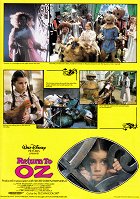Regie:
Walter MurchMusik:
David ShireBesetzung:
Fairuza Balk, Jean Marsh, Nicol Williamson, Piper Laurie, Matt Clark, Brian Henson, Stephen Norrington, Sophie Ward, Philip Tan, Deep Roy, Peter Elliott (mehr)Streaming (4)
Inhalte(1)
Dorothy ist von ihren weltberühmten Abenteuern mit dem Zauberer von Oz nach Hause zurückgekehrt, aber sie denkt ständig an jenes märchenhafte Land und ihre Freunde dort. Ihre Tante gibt sie daraufhin bei einem zwielichtigen Psychoanalytiker in Behandlung, der ihre rege Fantasie unter Kontrolle bringen soll. Doch Dorothy gelingt die Flucht vor ihm, und sie gelangt tatsächlich wieder nach Oz. Dort erlebt sie neue Abenteuer und muss neue Gefahren meistern, aber sie findet auch wieder zauberhafte Freunde, die mit demselben liebevollen Humor gezeichnet sind wie die Figuren des ersten Teils. (Verleiher-Text)
(mehr)Kritiken (2)
Irgendwo zwischen Die unendliche Geschichte und Die Reise ins Labyrinth steht diese inoffizielle Fortsetzung von Der Zauberer von Oz. Stilistisch ist es eine reine Dark Fantasy, die den zweiten und dritten Teil der Serie "Im Reich des Zauberers Oz" (1904) und "Ozma von Oz" (1907) adaptiert. Genau in diesem Geiste habe ich es genossen. Fairuza Balk ist großartig, Jean Marsh genial teuflisch. Baums Märchen wirkt nicht zu kindisch, sondern äußerst einfallsreich. Die Tricks sind genial, das Szenenbild prächtig. Außerdem sind meine Lieblings-Oz-Figuren Jack Kürbiskopf und Tik-Tok dabei.
()
Whereas some of the celebrated children’s movies that have become cult classics, such as The Peanut Butter Solution, now exhibit certain dramatic stumbles and it is necessary to squint one’s eyes to bring their loosely structured narratives into focus, Return to Oz is a perfect film that has not aged at all and is still able to draw in and captivate even adult viewers. In terms of craftsmanship, it is a refined work with flawless mechanical effects and an enchanting atmosphere that combines awe-inspiring fantasy with unsettling elements to create multiple meanings. This is due in part to the perfect Fairuza Balk, whose distinctive performance gives Dorothy a liveliness that transitions seamlessly between immediacy, timidity and childlike determination. In addition to that, the film is a phenomenal work in the context of the Wizard of Oz “franchise”, as it flawlessly bridges the gap between L. Frank Baum’s original vision and the bastardised canon established by the uncritically accepted canonical film adaptation from 1939. On the one hand, the narrative of Return to Oz is related to that of the old film, but instead of vaudevillian playfulness, it brings the world of Oz back to the darker and more unsettling form that Baum constructed in his books (which was preserved in the 1982 Japanese-American animated adaptation), while also brilliantly combining motifs from the second and third instalments of Baum’s book series into one distinct narrative. However, the screenplay does not literally follow on from the classic film, or more precisely, its primary meaning, where Dorothy adopts the conservative view that home is the best place to be. On the contrary, it is based on a subversive reading in which the trip to Oz is interpreted as a manifestation of the protagonist’s nature, which she must hide from those around her. Therefore, at the beginning of this sequel, Dorothy’s aunt takes her to a doctor to rid her of her fixations. When Dorothy gets back to the world of Oz after the anxiety-inducing introduction in the mental hospital, it’s not an escapist return to a colourful realm, as the Emerald City is in ruins and her friends have been turned to stone. The premise brings back to the world of Oz the danger that the creators of the old saccharine musical eliminated from Baum’s book. At the same time, it also opens up the central motif of Return to Oz, which is that Dorothy has to fight for her imagination and defend it against the selfish people around her – though not directly and actively, but simply by not letting herself be intimidated and by facing the obstacles and dangers with which she is confronted (which again corresponds to Baum’s books). In accordance with that, all of the characters that she meets, whether they join her as her guides or stand in opposition to her, are characterised by grotesque ambiguity and the individual peripeteias are rather bizarrely fantastical in the sense that they have their own logic and defy the usual ways of thinking about the real world (see the role of the hen, the form of Princess Mombi and the revived Gump). In every respect, Return to Oz is a brilliant work that ranks alongside the best children’s films, such as The NeverEnding Story and Hook, which do not approach the theme of childhood and imagination in a superficially naïve way. In its time, however, Return to Oz unfortunately ran up against the stubborn obtuseness of both viewers and publicists, who associate The Wizard of Oz only with the film and not the book and demanded another lobotomising musical. In contrast to that, Return to Oz is a flawless contribution to the trend of eighties children’s films that brilliantly combined adventure entertainment with darker tones and ambiguous motives, which was characteristic not only of the ambitious Amblin, but also of many other companies, including Disney, which, after all, funded Murch’s vision.
()
(weniger)
(mehr)

